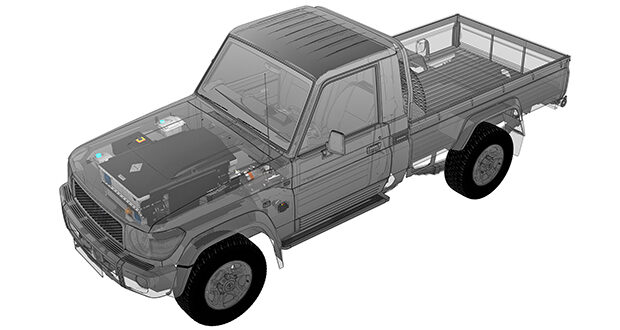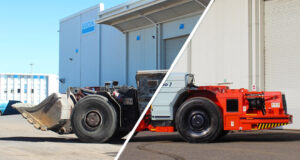Sustainable under challenging circumstances: Huber Automotive AG, Mühlhau-sen/Germany, is electrifying the Toyota Land Cruiser for use in mines. The newly developed version of the vehicle not only masters all of the demands of open-cast mining, but also contributes to reducing CO2 emissions and operating costs. The vehicle’s energy is delivered by the powerful standard battery system from Webasto SE, Gauting-Stockdorf/Germany.
Huber Automotive has supplied many German automotive industry OEMs with modern vehicle electronics for almost 40 years. This includes both hardware and software. Moreover, the company’s own vehicle concepts are produced in series at its headquarters in Mühlhausen, Baden-Württemberg. The company’s claim is: Shaping a sustainable mobile future. This is why Huber Automotive has been undertaking research and development in the field of e-mobility for over ten years. As an early adopter, the company is looking to the future with great confidence. The global mining industry is changing and needs sustainable vehicle concepts for transporting personnel and light equipment. Aside from ventilation, work machines and modes of transport consume the greatest amount of energy in mines, which is why switching to e-vehicles makes a significant contribution to reducing both emissions and costs. Huber Automotive is electrifying the Toyota Land Cruiser. This will enable it to travel around the site with no emissions, thereby meeting all of the health requirements demanded by the Occupational Health and Safety Regulation. This prescribes emission protection as an essential element and, correspondingly, all measures for limiting or preventing emissions.
Initial electrification of the Land Cruiser posed a number of challenges, because the new powertrain components all needed to be precisely accommodated inside the existing body and structure (Figure 1). It was also necessary to completely redevelop the vehicle’s communication architecture, because, aside from the mechanical ones, no other interfaces were available.
Huber Automotive is now supplying its own plants and worldwide partners with a system solution for converting the Land Cruiser. “Only in this way are they able to produce the vehicle concept so easily and quickly. Simultaneously, this requires a high level of quality and system modellability,” explains Fabian Schneider, Key Account Manager at Huber Automotive. Furthermore, the electric cruiser is used on rough terrain on a daily basis. This places enormous demands on the product which transcend the usual automotive industry requirements. In mining operations, the electric cruisers are regularly driven on gravel roads and through potholes. Vehicles get muddy and, in salt mines, have to contend with the associated corrosion.
Webasto’s integrated, high-performance standard battery system is proving useful for precisely these applications. The modular and scalable system for the electrified Toyota Land Cruiser operates at 400 V and has a capacity of 35 kWh. “In comparison with other chemical alternatives, the lithium-ion battery is particularly impressive due to its energy density. Thanks to its excellent power-to-weight ratio, the vehicle is even slightly lighter than with its original powertrain,” Schneider emphasizes. Correspondingly, the vehicle’s payload remains unchanged – offering a key benefit, especially when one considers how heavily vehicles are loaded in open-cast mining operations. To ensure a high level of operational safety, the battery system is protected against dust and water ingress to IP67 standards. It is moreover installed within a very robust housing.
The project commenced in 2016 and the first prototype was ready six months later. “Getting a drivable prototype on the road is a relatively rapid undertaking. But bringing it up to series production maturity takes time. The remainder of the development time stretched to four years in all, with the first two years dedicated to field testing,” outlines Schneider. Huber Automotive jointly tested the vehicle concept with a number of mine operators, and the experience gained during testing was incorporated into product development. In current series production operations, a new Toyota Land Cruiser is delivered to one of the company’s own plants or to one of its worldwide partners’ facilities, where the ready-to-install system solution is already waiting. There, the diesel vehicle’s powertrain is replaced with the electric version. “However, we don’t scrap the original powertrain’s components, but offer them on the spares market, where they are in high demand,” explains Schneider.
Webasto also supported product development for the electrified Toyota Land Cruiser by actively contributing to designing the system solution. To ensure the battery system is dimensioned to fit perfectly inside the body, its housing was shortened in coordination between the companies. “Webasto’s advice is very competent and professional. We also sometimes call in the experts for meetings with customers – especially when it comes to discussing the issue of safety. We can count on Webasto’s full support here,” reports Schneider.
Huber Automotive has subjected its electrified Toyota Land Cruiser to extensive safety testing. “From my perspective, we are offering the most robust product for the light mining vehicle market, one which also has the longest service life,” says Schneider. The myriad components of an internal combustion engine and its wider drivetrain that are subject to frequent wear have been replaced with low-maintenance components. This not only increases the vehicle’s service life, but also significantly reduces operating costs. Mining vehicles are constantly exposed to high stresses, so their service life is generally very short. However, the electrified Toyota Land Cruiser’s service life is significantly longer than that of conventional diesel-powered mining vehicles – somewhere between three and five years.
Looking ahead, Huber Automotive expects sales of its Electric Cruiser to enter the three- to four-digit-range in the near future. Their vehicles are already deployed worldwide and customers enjoy a range of services delivered locally, such as maintenance and training. Huber Automotive focuses on the European market in terms of retrofitting and services, while its partners focus on the African, Australian and Canadian markets. In other words, every major mining market on the planet will be served.
Further information:
Webasto SE
www.webasto.com


